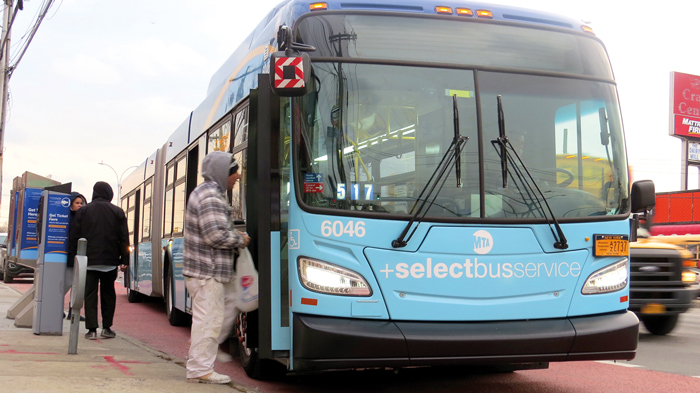Forum Photo by Michael V. Cusenza
The exhaustive, 432-page draft proposal, according to MTA officials, seeks to completely redraw borough bus routes.
By Forum Staff
The Metropolitan Transportation Authority on Tuesday released a draft plan to “dramatically” redraw the Queens Bus Network for the first time in 100 years.
The current sluggish system is composed of 77 routes within a widespread network that has three centers in downtown Flushing, downtown Jamaica, and Long Island City. The average bus speed in The World’s borough is 8.7 miles per hour, continuing an overall borough-wide slowdown since 2015, according to MTA New York City Transit. Roughly 52 percent of Queens’ 2.3 million residents rely on public transit for their daily commutes; 11 percent of those commuters rely solely on buses. More than 94 percent of Queens residents live within a five-minute walk of a bus stop. Bus stops in Queens are spaced very close together, leading to frequent bus stopping and longer commutes, MTA officials noted. Many stops are 500 to 1,000 feet apart, which, according to the MTA, is shorter than the average bus stop spacing system-wide and far closer than peer transit systems worldwide.
According to the agency, goals of the redesign include:
Improving bus speeds
Expanding bus priority such as bus lanes and use of traffic signal priority technology by working with the City Department of Transportation
Improving traffic enforcement through use of MTA’s automated bus lane enforcement initiative and close collaboration with DOT and NYPD
Improving connectivity at population centers and destinations, at intermodal transfer locations, and at emerging residential and commercial developments
Balancing bus stop spacing from an average of 850 feet apart to 1,400 feet by consolidating or removing closely spaced or under-utilized bus stops. On average, a bus takes 20 seconds to more than 1 minute to pull into a bus stop and then reenter traffic. NYC Transit bus stops are the closest-spaced in the country, some of which are as close as two blocks apart. When reviewing candidates for stops, NYC Transit considers factors such as geography and proximity to schools, colleges, hospitals, community centers, libraries or senior centers
Improving connections between areas with high densities of residents with mobility impairments and existing and future accessible subway stations
Working with the DOT to improve bus stop accessibility and customer amenities such as shelters, bus bulbs and real-time digital service information signs
The exhaustive, 432-page draft proposal, according to MTA officials, seeks to completely redraw the bus routes, which were mostly unchanged since they were converted from old trolley lines from the turn of the 20th century or consolidated from private bus companies that began serving Queens in the 1910s. Many of those companies served three central hubs in Queens, leading to three separate spoke-and-wheel networks to Flushing, Jamaica, and Long Island City that severely limited the coverage area.
The draft plan takes into consideration the service performance of each bus route, the speed, ridership and reliability on key corridors, and how individual routes contribute to the larger network. Recommendations were developed in collaboration with DOT, with focus given to identifying key corridors where roadway treatments and traffic signal improvements can be implemented to expand bus priority and better support sustainable, all-day bus service. The details of DOT’s proposed bus priority plan for Queens are included in the draft plan.
For more information a list of public outreach sessions regarding the proposal, visit new.mta.info/queensbusredesign.

